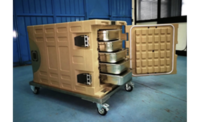When choosing the best printed labels for your food products, there are many things to consider.
For starters, types of adhesive used in any labeling that come into contact with food products, whether directly or indirectly, must comply with safety guidelines to prevent contamination.
Here are the most important things to consider when deciding what kind of printed label is most suitable for your product:
Direct food contact labels
Direct contact food labels are adhesive labels that come into direct contact with a raw food product, for example, fruits and vegetables.
Direct food contact labels also include those that are applied to external packaging with thin barriers, or microperforations, because the label adhesive still has the potential to migrate and potentially contaminate the food product.
When food products are labeled in this manner, there is a strong probability that substances will leach, or migrate, from the label and onto the food itself. For this reason, the adhesive must be completely non-toxic and must not alter the taste, smell or appearance of the product in any way.
The type of ink used on printed labels is also important to consider, as some, such as UV inks, can alter the taste and smell of food products even when applied to external packaging.
If you intend for your labels to touch the surface of a raw food product with an edible skin, the adhesive and inks used on these labels must be FDA-approved. These materials are indirect food additives and must be safe for human consumption.
Indirect contact labels
Indirect food contact labels refer to adhesive labels that do not come into direct contact with food. This applies to food packaged in thicker materials, or food with a peel that is not typically eaten, such as bananas or oranges.
Even if your printed labels are applied to a thick, external packaging and are not intended to come in contact with food, the proximity to the food product means migration of ink and adhesive particles will occur.
Even if only minute amounts of your labeling material make it onto your food product, it is still crucial to ensure these materials meet FDA safety regulations. This will guarantee the safety and quality of your product and prevent any unwanted alterations to its taste and smell.
Other considerations
Once you have decided whether direct or indirect contact labels are best suited for your product, there are other factors you must consider before choosing what type of adhesive and ink to use on your printed labels.
Storage time. Products with a long shelf life that are intended to be stored for long periods of time will experience increased leaching of compounds and substances from the labeling into the food product.
It is critical you consider this when selecting materials for your printed labels because these products are ultimately going to contain higher levels of contaminants from the labels than products with a shorter shelf life. Any inks or adhesives used must, therefore, be entirely non-toxic and be in accordance with FDA regulations
Dry vs fatty foods. The type of adhesive label best suited for your product will also vary depending on whether the food product in question is dry or fatty.
Fatty foods, such as cheese, sausage or chocolate, have a composition that may facilitate the migration of substances from the printing or adhesive used in the labels. This can result in a greater amount of these substances making their way into the actual food product when compared with dry foods, such as fruits and vegetables.
Temperature. Higher temperatures facilitate the leaching of substances from packaging into the food product, so if your product is intended for storage at ambient temperatures, it is more likely to contain contamination from the labeling than products that are meant to be refrigerated or frozen.
It is important to choose your labeling materials accordingly, and opt for materials that are safe for human consumption, as products stored at a higher temperature will have a relatively high migration rate.
When it comes to selecting labeling materials for food products, it is of vital importance to ensure all adhesives and inks used in the process are food safe to protect both the quality of your product and the safety of consumers.
The suitability of adhesive and ink materials depends entirely on the rate of migration of compounds and substances used in packaging onto the food itself. Certain types of foods can facilitate the migration of substances into the food product, causing increased rates of leaching. Other factors that increase the rate of migration are increased temperature and long storage times.
Some products will ultimately end up with a greater quality of contaminants than others, and it is crucial to choose materials that are suitable for your product, are FDA approved and pose no threat to human health.
The proximity of your printed labels to your food is also a necessary consideration when choosing labels, as differing guidelines govern which materials can be used in labels that are to have direct contact with the food product compared to labels with no direct contact.
Once you have determined what kind of labeling is most suitable for your food product, you can decide what types of adhesive and ink are best for ensuring safety and quality. If you are unsure, consult with a professional in the label industry. They can provide guidance on the correct label, ink and adhesive to use, especially if you store your food at various temperatures. Ultimately, the safety of your consumer is first priority.



